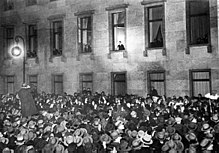Nazi seizure of power
This article includes a list of references, related reading, or external links, but its sources remain unclear because it lacks inline citations. (May 2011) |
| Part of a series on |
| Nazism |
|---|
Machtergreifung (German pronunciation: [ˈmaxtʔɛɐ̯ˌɡʁaɪfʊŋ] ⓘ) is a German word meaning "seizure of power". It is normally used specifically to refer to the Nazi takeover of power in the democratic Weimar Republic on 30 January 1933, the day Hitler was sworn in as Chancellor of Germany, turning it into the Nazi German (Third Reich) dictatorship.

Term
The term Machtübernahme ("takeover of power") is also used for this event. Note that, when used in German, both Machtergreifung and especially Machtübernahme retain their more general meanings and the latter is not particularly related to the Nazis. Machtübernahme means any takeover of power, whether peaceful and legitimate or violent and illegitimate.
The term Machtergreifung was first coined by the Nazis themselves in order to portray their accession to power as an active seizure (an alternative term used was Nationale Erhebung 'national rising'). Since Hitler's appointment as chancellor was more a result of intrigue rather than of an active revolution, the term has been criticized by historians and is sometimes replaced with the term Machtübertragung ("handing-over of power") or, more polemically, Machterschleichung ("sneaking into power").
Another name commonly used for the Nazi seizure of power in 1933 is the Brown Revolution,[1] referring to the brown-coloured shirts that served as the uniform of the SA, for which its members were known as "brownshirts".
History
The Nazis had learned from the failed Beer Hall Putsch of 9 November 1923 and developed a "Legalitätsstrategie" (legality strategy) for their "National Revolution" to formally observe the law.

After the huge success of the Nazi Party in the 1930 elections, the government of Heinrich Brüning (Centre) tried to keep the state and constitution alive through a minority government supported by the Social Democrats. Brüning pushed through a law proscribing the Nazi SS and SA paramilitary organizations, which had to be revoked in 1932 after pressure of right-wing forces around Kurt von Schleicher. Seen from an economic perspective, Brüning made unemployment worse through his rigid program of public budget balancing. On 1 June 1932 Reich President Paul von Hindenburg, urged by Schleicher, appointed the non-partisan Franz von Papen chancellor, who strove for collaboration with the Nazis to use their popularity with the masses for himself. A coalition between the centre, the German National People's Party (DNVP), and the Nazis failed because of Hitler's demand for chancellorship. Since Papen had courted the Nazis, he did not forbid the NSDAP as a seditious party though the Boxheimer Dokumente written by Werner Best in 1931 revealing plans for a putsch by the Nazis, could have given rise for stern measures.
The Machtergreifung was followed by the Gleichschaltung, the period until around 1934 characterized by systematic elimination of non-Nazi organizations that could potentially influence people, such as trade unions and political parties.
See also
References
- ^ Toland, John (1978). "The Brown Revolution". Hitler: The Pictorial Documentary of his Life. Garden City, New York: Doubleday & Sons. pp. 42–60. ISBN 0-385-04546-8.
Further reading
- Evans, Richard J. (2003), The Coming Of The Third Reich, London: Allen Lane, ISBN 0-7139-9648-X.
- Frei, Norbert (1983), "Machtergreifung. Anmerkungen zu einem historischen Begriff", Vierteljahrshefte für Zeitgeschichte (VfZ), 31: 136–145 Template:De icon.
- Jasper, Gotthard (1986), Die gescheiterte Zähmung. Wege zur Machtergreifung Hitlers 1930-1934, Neue Historische Bibliothek, Frankfurt am Main: Suhrkamp, ISBN 3-518-11270-8 Template:De icon.
